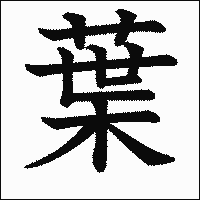Dear All Leafers,
This is for real Japanese language fans, or anyone with just too much curiosity about the origin of the name "Treeleaf."Other folks (you have been warned) may want to take this opportunity to "make like a tree, and just leave!"
Just a little fact I noticed yesterday when reading about the kanji (Chinese-Japanese Character) for "Leaf." Even if you are not a student of Japanese, it may be interesting somehow. Maybe not so much.
Our Sangha's "official name in Japanese is the "Ko no ha" (木之葉) Zendo, in which the first character means (and looks like) a tree (木), the "no" (之) is a possessive (like an apostrophe 's in English), and the final kanji (葉) means leaf. So, it means "tree's leaf" or "leaf of the tree" ... Treeleaf. Here is the name written by Nishijima Roshi as it hangs over our door in Tsukuba ...
If you are ever wondering about the origin of the name, well, I first thought that this Sangha connected by the internet around the world is like the leaves on the branches of a tree, but also all the separate things of this world ... including you and me ... are like the myriad individual leaves on a tree which are also united together and, in fact, ARE the tree itself manifesting. The leaves are the tree itself in most intimate sense, as the tree comes to life in each and every leaf. I also thought of other famous trees in Buddhism and Zen, such as the Bodhi Tree under which the Buddha sat, and the "Cypress Tree in the Garden" which is the response in a famous Koan.
In any case, I was always a little bothered by that possessive (之) in the Japanese name, because it implies that the leaves merely belong to the tree, and not that they are actually the tree itself in most intimate sense in one facet and guise. To express that, our name is "Treeleaf" and not just "tree leaf" or "leaf of the tree."
Well, to make a long story slightly less long ...
Yesterday, I was doing my daily Japanese studies (at my age, just to maintain what is already in my head as much as to learn something new), and I came to an explanation of the elements of the third Kanji, the one for "leaf" itself ... "Ha" (葉):
In other words, the Leaf is the Tree within (and is not just part of the tree) and is the tree's successive generations of sprouting life. Perhaps the whole meaning of Treeleaf is just contained in that one Kanji ... 葉 . So, the leaf is of the tree, but the tree is in the leaf too. Here it is in a nice calligraphy ...The kanji 葉 (ha, which also can be pronounced yō), has the core meaning “leaf.” Mastering the shape of 葉 is a snap if you divide it into its three top-to-bottom components — 艹 (plant-life), 世 (generations) and 木 (tree) — and memorize the phrase, “Leaves are successive generations of plant life on a tree.”
Maybe you have to be a Japanese language wonk to find this sublime.
Gassho, J
STLAH






 Reply With Quote
Reply With Quote














